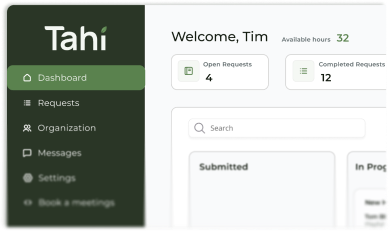Graphic Design
Accessibility Isn't an Add-On. It's a Core Part of Good Design.
Designing for accessibility isn't an optional extra. It's a fundamental principle of great design that creates better, more inclusive experiences for everyone.

Redefining 'Good Design' Beyond a Pretty Picture
When we talk about 'good design', it's easy to think only of aesthetics. We picture beautiful layouts, elegant typography, and a stunning colour palette. And while those things are important, they are only one part of the story. True quality in design isn't just about how something looks. It's about how it works, how it feels, and who it works for.
At its heart, good design solves problems. It creates clarity from complexity and provides an intuitive path for a user to achieve their goal. If a design, no matter how visually appealing, creates barriers for a portion of its audience, can we really call it 'good'? We don't think so. This is why, at Tahi Studio, we believe accessibility isn't a feature to be tacked on at the end of a project. It is a fundamental, non-negotiable part of the design process itself.
The Four Pillars of an Accessible Web
To build truly accessible digital experiences, we lean on the Web Content Accessibility Guidelines (WCAG). These aren't just a list of technical rules. They are built on four core principles that provide a solid foundation for inclusive design. Known by the acronym POUR, they help us ensure that our work is usable by as many people as possible.
1. Perceivable
This principle ensures that users can perceive all the information presented to them. It means we cannot rely on a single sense, like sight or hearing. For example, every meaningful image on a website should have alternative text (alt text). This text is read aloud by screen readers, allowing a visually impaired user to understand the image's content and context. It's also what search engines use to understand imagery, which is a great bonus for SEO.
2. Operable
An operable website means that everyone can use its controls, buttons, and navigation. Many people cannot use a mouse due to motor impairments and rely entirely on a keyboard to navigate. A core part of our development process is ensuring every interactive element, from dropdown menus to submission forms, can be accessed and activated using the tab, enter, and arrow keys. We also ensure that animations and moving content don't cause adverse reactions and can be controlled by the user.
3. Understandable
This pillar is about clarity and consistency. The content and the operation of the user interface must be easy to comprehend. This involves using clear and simple language, avoiding unnecessary jargon, and creating predictable, consistent navigation across the entire website. When a user knows what to expect, they feel more confident and in control. This benefits everyone, from users with cognitive disabilities to someone who is simply distracted or in a hurry.
4. Robust
A robust website is one that can be reliably interpreted by a wide variety of user agents, including assistive technologies like screen readers. This is where quality development really shines. By using clean, semantic HTML and following modern coding standards, we build websites that are compatible with current and future technologies. It's about future-proofing the digital foundation so it remains accessible as technology evolves. You can learn more about these foundational principles directly from the World Wide Web Consortium (W3C).
The Ripple Effect. How Everyone Wins with Inclusive Design
One of the most powerful truths about accessibility is that it rarely benefits only one group of users. This is the core idea behind Universal Design, a framework that encourages creating products usable by all people, without the need for adaptation. Microsoft's design team puts it perfectly: "When we design for disability, we all benefit."
Think about these common scenarios:
- Video Captions: Originally designed for users who are deaf or hard of hearing, they are now widely used by people watching videos in a noisy office, on public transport, or late at night without waking their family.
- High Contrast Text: Essential for users with low vision, but also a huge help to anyone trying to read their phone screen in bright sunlight.
- Clear, Simple Forms: Designing forms that are easy to navigate for users with cognitive disabilities also makes them less frustrating and quicker to complete for every single user.
By solving for a specific need, we often create a better, more flexible experience for the entire audience. It shifts the focus from 'us' and 'them' to just 'us', a core principle we embrace in our partnerships.
The Inarguable Case for Accessibility
If the ethical imperative to build an inclusive web isn't enough, the business case is just as compelling. Considering accessibility from day one is far more cost-effective than trying to retrofit a website later. Retrofitting often involves extensive redesign and redevelopment, leading to higher costs and compromised solutions.
Furthermore, ignoring accessibility means ignoring a significant portion of the market. In the UK alone, the collective spending power of households with at least one disabled person, often called the 'Purple Pound', is estimated at a staggering £274 billion a year. An inaccessible website is effectively closing its doors to these potential customers. Recent design statistics show that user experience is a key brand differentiator, and accessibility is a massive part of that experience.
Building an accessible digital presence isn't just an act of social responsibility. It's a strategic business decision that expands your audience, protects your brand, and improves the overall quality of your digital foundation.
How We Weave Accessibility into Our Fabric
For us at Tahi Studio, accessibility is not a box-ticking exercise. It's woven into our process from the very first conversation. It's part of our commitment to uncompromising quality and true partnership.
During the design phase, we consider colour contrast, typographic clarity, and logical information architecture. In development, our Webflow experts build with semantic HTML, ensure full keyboard navigability, and test across various devices. We don't see this as extra work. We see it as the right way to build a website.
Our goal is to deliver a digital asset that works for you, your business, and every single one of your customers. A website that is welcoming, easy to use, and built on a solid, inclusive foundation is a website that is truly designed for growth.
Let's shift the conversation. It's time to stop asking 'if' we should make our sites accessible and start asking 'how' we can make them even better for everyone. If you're ready to build a website with a truly solid foundation, we're ready to have that conversation. Explore our services or start with a free site audit.








